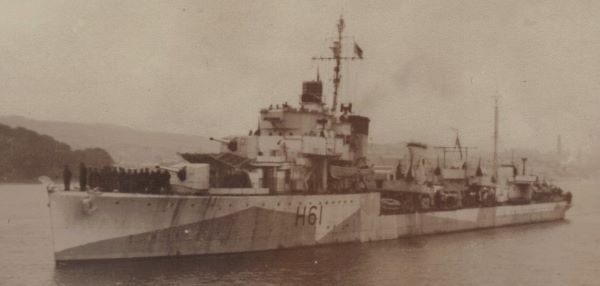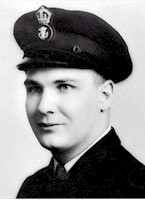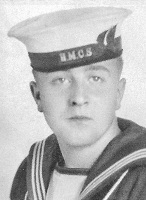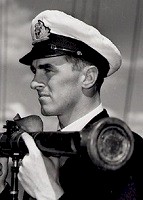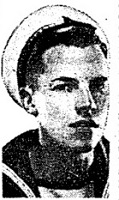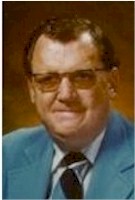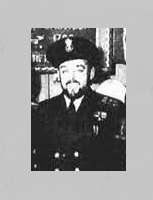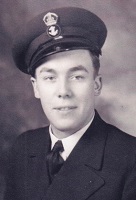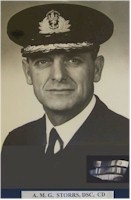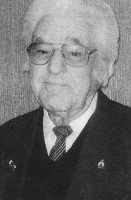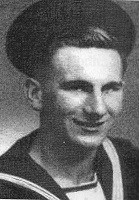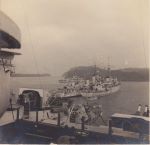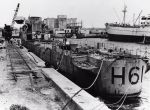|
HMCS GATINEAU H61
E - Class Destroyer (RN)
River Class Destroyer (RCN)
HMS Express H61, was built on the Tyne by Swan Hunter and engined by the Wallsend Slipway. She was laid down on 24 March, 1933, launched on 29 May, 1934 and commissioned on 2 November of the same year. She served in the Fifth Destroyer Flotilla with the Home Fleet until 1939.
Just
before war broke out, she had been fitted for mine-laying and on 9
September, 1939, she and HMS Esk, a sister ship, laid the first British
offensive mine field of the war in the Heligoland Bight. On another
mine-laying operation off the Dutch coast on 31 August, 1940, she, Esk and
Ivanhoe all struck German mines before they could lay their own. Express was
severely damaged and was towed back to the Humber for repairs, but the other
two destroyers were sunk.
In late 1942 the Canadian cabinet asked Britain for the loan of eight destroyers to reinforce the escort groups on the North Atlantic convoy routes. The Admiralty responded with the gift of six of which Express was one. They had already begun to refit her for escort duties and it only remained to rename her GATINEAU after the river flowing into the Ottawa and to provide her with a Canadian crew. The river, in turn, took its name from a French fur trader and civic official, Nicholas Gatineau, who developed it as a trade route that took him around Iroquois territory safely to the Hurons’ hunting grounds. He disappeared in 1683 – according to rumour he was drowned in the river.
HMCS GATINEAU was commissioned into the Canadian fleet on 3 June, 1943, and sailed from the United Kingdom on 2 July as Senior Officer of Escort Group C-2 escorting Convoy ON-191. She quickly settled into the routine of the “Newfie-Derry run” – the work of the Mid-Ocean Escort Force plying between St. John’s, Newfoundland, and Londonderry in Northern Ireland. The U-boats, badly beaten early in the year, stayed away from the North Atlantic convoys until September. GATINEAU sailed on 15 September in charge of the escort of ON-202 which, in company with ONS-18, was beset by twenty-one U-boats. Of particular importance in this convoy battle is the fact that this “wolf-pack” was armed with acoustic torpedoes (called GNATS by the Allies) for use against escort vessels. The U-boats made contact with the convoy on the evening of the 19th and the running fight continued for five days and nights into the early morning of the 24th. HMS Lagan was the first to become a casualty to the GNAT when she was damaged at 0303 on the morning of 20 September, but U-341 had already been sunk by an aircraft.
HMCS ST. CROIX and HMS Polyanthus were sunk the same evening. On 22 September, HMS Keppel sank U-229 and the same night HMS Itchen was sunk taking to the bottom all but two of her own ship’s company, all but one of the survivors from ST. CROIX and the only man picked up from Polyanthus. Also sunk in the action were six merchant ships so that the final score was three U-boats sunk for a loss of three escort vessels sunk and one damaged and six merchantmen sunk.
GATINEAU had been slightly damaged by her own depth-charges in the action and had to be hauled out at Bay Bulls for repairs to her stern glands. Then, in mid-November, after four more passages across the Atlantic, she was sent to Halifax dockyard to be fitted with heating apparatus to make her more comfortable for her crew in winter. This was her first visit to a Canadian port since Newfoundland was a crown colony at that time.
She rejoined C-2 group, but was no longer Senior Officer, and after an east-bound convoy she found the group allocated to “Support” duties. This meant it joined a convoy in addition to its close escort and gave extra protection through the more dangerous parts of its passage. They sometimes spent even longer at sea at a stretch because the ships would sail from Londonderry (where C-2 was based) with a west-bound convoy, accompany it for about two-days, transfer to an east-bound convoy for a day, then to a west-bound again and so on, fuelling from tankers in the convoys as it became necessary.
The Senior Officer of a Support Group had greater freedom of action than he would if he were in command of the close escort because he could leave the convoy, if there were no immediate danger, to follow a promising scent. Just such a case occurred in March, 1944 when GATINEAU made contact with a U-boat while supporting Convoy HX-280. This led to a “hunt to exhaustion” which lasted from 1000 on 5 March to 1830 on the 6th. GATINEAU herself had to leave the hunt during the night because she was short of boiler feed-water, but her contact led to the sinking of U-744 by the other ships of the group. Even after having about two hundred depth-charges and three patterns each from squid and hedgehog dropped on her, the U-boat was little damaged and was prepared to fight it out with her guns when she broke surface, but she expected to find only two escorts waiting for her. As it was she was deluged with shell from five ships and never got a man to her guns. She surrendered almost at once. It was only her air supply that had been exhausted.
At the end of April, 1944, GATINEAU, along with the other destroyers in the Mid-Ocean Escort Force, was withdrawn from the Atlantic. She was allocated to Escort Group No. 11, consisting entirely of Canadian “River” Class destroyers, for duty in the English Channel for the landings on the Norman coast. The work was mostly patrolling the supply lines to protect them against submarines. HMC Ships OTTAWA (Senior Officer) and KOOTENAY and HMS STATICE distinguished themselves by sinking a U-boat on 7 July, but GATINEAU was elsewhere at the time. Just a few days later her boilers blew several tubes and it was decided to send her home for a refit. This kept her in Halifax from August, 1944 to February, 1945, and it was 1 May, a week before VE-Day, before she was ready to sail again from Londonderry for operations with EG-11.
During that week she carried out patrols in the channel. On 12 May the group carried out Operation “Nestegg” the reoccupation of the Channel Islands. They escorted the transports that landed British troops on the islands and carried out patrols off shore afterwards. It was not clear yet whether all U-boats had heard of the end of hostilities so EG-11 had more patrols and two channel convoys to escort before they sailed northward for Londonderry on 23 May. On the 30th they called at Greenock, picked up homeward-bound Canadian naval personnel and sailed for home. On 6 June they arrived in Halifax and EG-11 was disbanded.
GATINEAU’s first peace-time duty was to act as transport - she paid another call to Greenock to bring Canadians home taking from 22 June to 10 July for the two-way passage. Then she was allocated to HMCS ROYAL ROADS, the Royal Canadian Naval College, for sea-training duties, and sailed for the west coast on 11 August, 1945, arriving 5 September at Esquimalt. She commenced a refit for training work but before it was complete HMCS CRESCENT, a more modern ship, became available and GATINEAU was paid off on 10 January 1946.
In March 1947, when the fleet was being reduced, GATINEAU was declared surplus and later the same year she was sold and broken up. (Source: Canadian Virtual Military Museum on facebook. Credit: CFB ESQUIMALT NAVAL & MILITARY MUSEUM)
It is believed that GATINEAU was scuttled at Royston, B.C. in 1948, as part of a breakwater.
U-Boats Sunk: U-744 (Oblt Heinz Blischke) a type VIIC U-boat, sunk on 06 Mar 1944 by HMCS ST CATHARINES K325, HMCS CHILLIWACK K131, HMCS GATINEAU H61, HMCS FENNEL K194, HMCS CHAUDIERE H99, HMS ICARUS and HMS KENIWORTH CASTLE in position 52-01 N, 22-37 W. Of her crew of 51, there were 40 survivors
Commanding Officers
They shall not be forgotten
Former Crew Members
Photos and Documents
(GTN001)HMCS GATINEAU H61 // From the collection of Eric Baird // Courtesy of Roger Clarke (GTN002) HMCS GATINEAU H61 circa 1943-1944 // Photo taken from HMCS KAMLOOPS K176 // From the collection of Kenneth Medford, DSM // Courtesy of Gary Medford (GTN003) Canadian Naval Craft Sink German U-boat // The Halifax Chronicle 01 Jun 1944 // Researched by / Courtesy of George Newbury // Ships mentioned in the article: HMCS GATINEAU, HMCS CHAUDIERE, HMCS CHILLIWACK, HMCS FENNEL, HMCS ST CATHARINES, HMS ICARUS (GTN004) Newspaper article on HMCS GATINEAU's Mascot Topsy, and Topsy's owner, AB William Evans of Toronto, ON // Crow's Nest newspaper - Sep 1944 (GTN005) HMCS GATINEAU H61 Christmas Card // From the collection of George Howse // Courtesy of Dennis Carson
(GTN006) Allied ships. Photo taken from the bridge of HMCS JOLIETTE K418 // The ships in the centre are HMCS GATINEAU (left) and HMS TARBERT K431 - Tobermory Mar/Apr 1945 // From the collection of Glendon Oliver // Courtesy of Keith Oliver (GTN007) The former HMCS GATINEAU H61 being broken up at Capital Iron & Metal, Victoria, BC // From the collection of Dick James // Courtesy of Steve Hlasny
|

